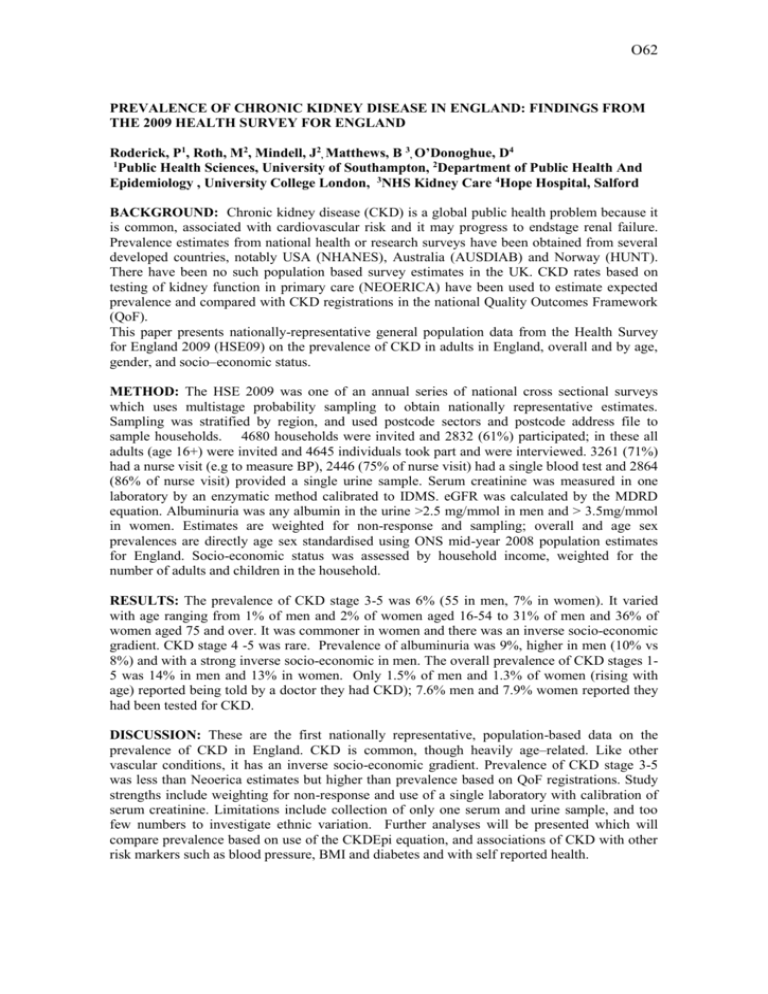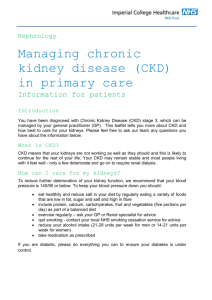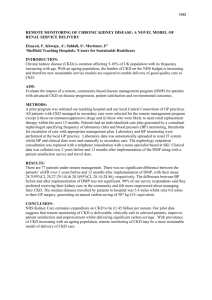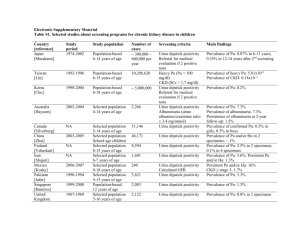Findings from the 2009 Health Survey for England
advertisement

O62 PREVALENCE OF CHRONIC KIDNEY DISEASE IN ENGLAND: FINDINGS FROM THE 2009 HEALTH SURVEY FOR ENGLAND Roderick, P1, Roth, M2, Mindell, J2, Matthews, B 3, O’Donoghue, D4 1 Public Health Sciences, University of Southampton, 2Department of Public Health And Epidemiology , University College London, 3NHS Kidney Care 4Hope Hospital, Salford BACKGROUND: Chronic kidney disease (CKD) is a global public health problem because it is common, associated with cardiovascular risk and it may progress to endstage renal failure. Prevalence estimates from national health or research surveys have been obtained from several developed countries, notably USA (NHANES), Australia (AUSDIAB) and Norway (HUNT). There have been no such population based survey estimates in the UK. CKD rates based on testing of kidney function in primary care (NEOERICA) have been used to estimate expected prevalence and compared with CKD registrations in the national Quality Outcomes Framework (QoF). This paper presents nationally-representative general population data from the Health Survey for England 2009 (HSE09) on the prevalence of CKD in adults in England, overall and by age, gender, and socio–economic status. METHOD: The HSE 2009 was one of an annual series of national cross sectional surveys which uses multistage probability sampling to obtain nationally representative estimates. Sampling was stratified by region, and used postcode sectors and postcode address file to sample households. 4680 households were invited and 2832 (61%) participated; in these all adults (age 16+) were invited and 4645 individuals took part and were interviewed. 3261 (71%) had a nurse visit (e.g to measure BP), 2446 (75% of nurse visit) had a single blood test and 2864 (86% of nurse visit) provided a single urine sample. Serum creatinine was measured in one laboratory by an enzymatic method calibrated to IDMS. eGFR was calculated by the MDRD equation. Albuminuria was any albumin in the urine >2.5 mg/mmol in men and > 3.5mg/mmol in women. Estimates are weighted for non-response and sampling; overall and age sex prevalences are directly age sex standardised using ONS mid-year 2008 population estimates for England. Socio-economic status was assessed by household income, weighted for the number of adults and children in the household. RESULTS: The prevalence of CKD stage 3-5 was 6% (55 in men, 7% in women). It varied with age ranging from 1% of men and 2% of women aged 16-54 to 31% of men and 36% of women aged 75 and over. It was commoner in women and there was an inverse socio-economic gradient. CKD stage 4 -5 was rare. Prevalence of albuminuria was 9%, higher in men (10% vs 8%) and with a strong inverse socio-economic in men. The overall prevalence of CKD stages 15 was 14% in men and 13% in women. Only 1.5% of men and 1.3% of women (rising with age) reported being told by a doctor they had CKD); 7.6% men and 7.9% women reported they had been tested for CKD. DISCUSSION: These are the first nationally representative, population-based data on the prevalence of CKD in England. CKD is common, though heavily age–related. Like other vascular conditions, it has an inverse socio-economic gradient. Prevalence of CKD stage 3-5 was less than Neoerica estimates but higher than prevalence based on QoF registrations. Study strengths include weighting for non-response and use of a single laboratory with calibration of serum creatinine. Limitations include collection of only one serum and urine sample, and too few numbers to investigate ethnic variation. Further analyses will be presented which will compare prevalence based on use of the CKDEpi equation, and associations of CKD with other risk markers such as blood pressure, BMI and diabetes and with self reported health.








